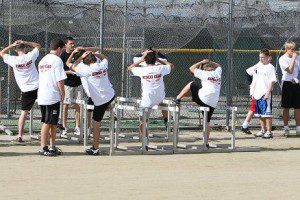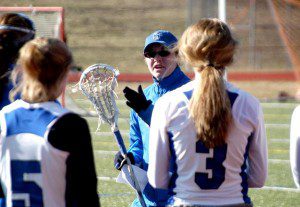Advanced “Prehab” Techniques to Avoid Injury
Posted by Kellie Corbett in College, High School, Off Season, Training, tags: TrainingAside from a more focused and active warm up routine, other prehab techniques included strengthening the muscles that surround a joint. Knees, shoulders, ankles, and hips are the joints that most often become injured in sports. Ligaments and tendons are the parts of the body that connect our bones to each other, and our muscles to our bones. These structures themselves cannot be strengthened, so we are responsible for protecting those structures that are placed under a lot of wear and tear, by building strong muscles that surround them.
Knees, for example, twist and bend and straighten with high torque and force. To protect the ligaments in the knee (especially the ALC and MCL), athletes need to have strong quadriceps and hamstrings. Exercises that can help are lunges, squats, step ups, dead lifts, knee drives, etc. Another important aspect to consider is the form in which you bend your knees. The knee should never bend forward over the toes, and should never collapse inward toward your other leg (into a valgus position). When performing lunges and squats, pay attention to and correct any form issues you may have so that you are training those muscles to keep the joint aligned while performing in your sport.
Shoulders are prone to dislocation and separation, especially for throwing athletes. The shoulder cuff is made up of four muscles that keep the shoulder in its socket. The muscles are very small, so training and strengthening them should not use much weight. A good way to do this is to focus on external rotation exercises using small dumbbells or resistance bands. These can be done overhead or out to the side. Another beneficial movement is scapular retraction which is done with exercises like rows along with the stretching of the chest by placing hands on the outside of a doorframe and stepping through the doorway.
To prevent broken or sprained ankles, the three tiny ligaments on the outsides of the ankles must be protected. The muscles to strengthen are the muscles of the calf and foot. These are easily strengthened using a four way resistance band, or heel- toe walking. Although simple, these muscles are important to strengthen.
The hips are prone to tightness and straining. To prevent this from happening, the athlete must have a strong core. Core exercises are extremely important to every sport because they provide the base of balance and support for the rest of the body. The core can be strengthened in many ways. It is important, however, to realize that the core includes not only abdominals, but the back as well. Good back exercises include supermans, roman chair, and exercises on a swiss ball, alternating leg and arm extensions.
So to keep yourself safe, out of the training room, and on the field, it is important to concentrate and put forth a real effort to protecting the body that performs all the intense movements that make you a good candidate for collegiate athletics. If your body is injured, it can’t perform, so make sure to take pride in exercising properly by warming up well with a focused dynamic stretch routine, and good form in a lifting routine to strengthen the muscles that will protect your joints from injury.







